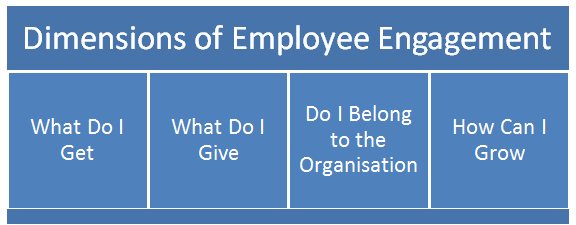Characteristics of Engaged Workforce
April 3, 2025
 Characteristics of Engaged Workforce
Characteristics of Engaged Workforce
The level of employee engagement can be measured by the willingness and ability of employees to contribute to the success of their organisation. It is their discretionary effort which is an essential element for the good health and well being of a company. A highly engaged workforce shows the high level of engagement in their…
 Challenging Work as a Driver of Employee Engagement
Challenging Work as a Driver of Employee Engagement
Introduction We often hear the term employee engagement being spoken about in various contexts. We are often told by management experts that engaged employees are a source of sustainable competitive advantage. During earlier periods of organizational theory and practice, it was common for the HR (Human Resources) function to take care of administrative aspects such…
 Benefits of Employee Engagement
Benefits of Employee Engagement
History records how Alexander was able to march on and conquer hitherto unknown lands due his valour and his motivated troops. However, the same history also records, how dissent amongst his troops towards the latter part of his career, cut short his ambitions of supremacy in Asia. Alexander started hiring more outsiders, laying off his…
The only thing that makes highly productive organisations stand apart from rest of the companies is the quality of the employees and the level of their commitment towards their work. The vice versa, the trust that an organisation shows in their employees and efforts that it makes to keep them focussed, motivated and satisfied, also is one of the many variables that distinguish between highly reputed workplaces and those that are not up to the mark.
Organisations cannot achieve their goals just by defining their mission statement nor can they foster a high performing work culture until they take substantial steps. They need people to get the jobs done and that too with excellence.
For fulfilling all their goals, organisations require actively engaged employees. Employee engagement happens only in those organisations which treat their people as their biggest assets and take care of their basic necessities and other psychological needs. Workplaces that meet all these conditions of employee engagement grow much faster and sustain much longer that those who fail to meet them.
There are different dimensions of employee engagement that make productive organisations stand apart from the rest and determine their destiny.
Things like what employees get in exchange for the efforts they put to perform the delegated tasks, if employees are able to perform their best, if they are treated as an important asset or just a means to perform the job and how they can grow if they stick to their organisation are of great importance. Actually these are emotional elements revealing the basic employee needs. They would like to contribute only when their efforts are recognised and awarded. Not only this, all they can also drive them to be more efficient while delivering their jobs.

What Do I Get: Employee engagement to an extent depends upon what people get in exchange for performing the job. This includes basic compensation, benefits, organisational culture and working environment. These are basic elements that motivate them to join the organisation and perform the given task with complete dedication.
What Do I Give: As it is a two way process, setting clear expectations plays an important role. This helps employees to understand what exactly they are expected to give the organisation. This includes defining their job responsibilities that they need to fulfil and tasks that they need to perform. The human resource team and immediate supervisors or managers need to tell them clearly what they are expected to do. It creates more meaningful relationships among seniors and subordinates and workgroups.
Do I Belong to the Organisation: Social association is the most basic requirement for anyone. Even employees would like to stay with the organisation that treats them as their integral part and not just the means to get the job done. ‘My opinions Count’ gives them satisfaction and motivates them to put their best to meet organisational goals.
How Can I Grow: Continuous growth including promotions, salary hikes and rewards and recognition are most essential tools to retain employees in the organisation. New challenges and opportunities to learn keep them motivated towards their work life and encourage them to give their best even during crisis.
Your email address will not be published. Required fields are marked *